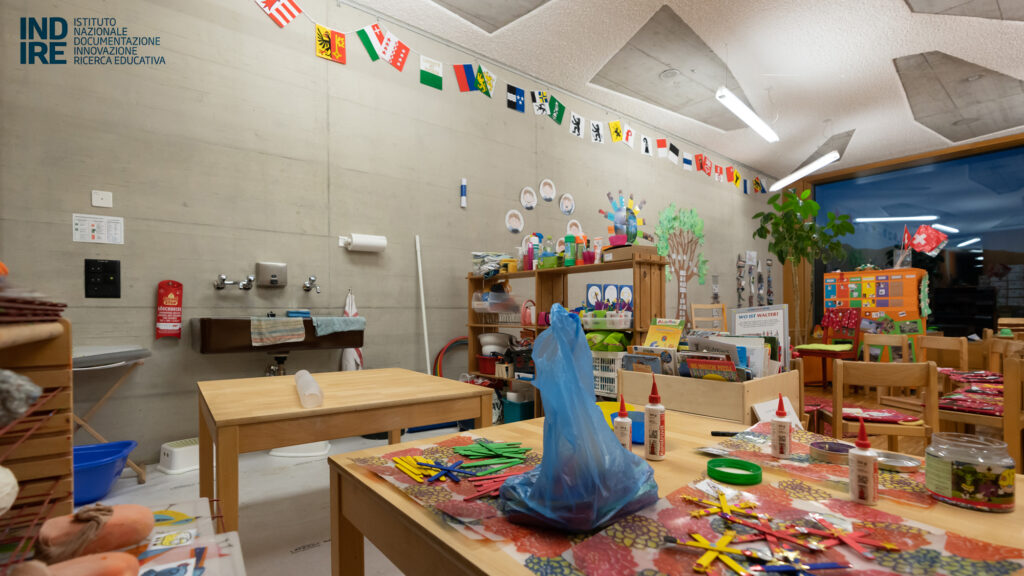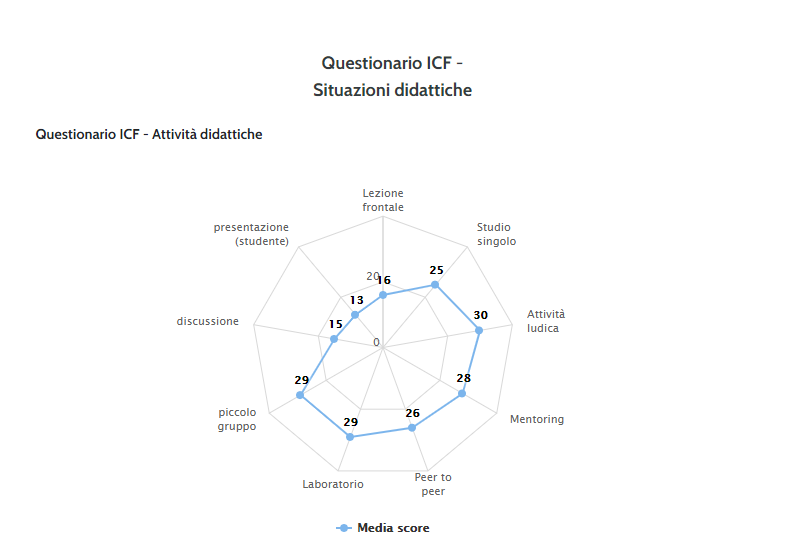The context of the talk
How much can the organisation of space foster inclusive processes? Indire’s research has developed the idea that attention should not be directed to the individual, fleeting student, but to all students in their individuality.
It is with this approach that Indire designed the training course for the teaching staff of the USR [Ufficio Scolastico Regionale – Regional School Department] in Tuscany, “New educational spaces in an inclusive perspective”, which ended on 18 January 2021.
Designing the school space means, first of all, thinking about the various teaching situations that can be chosen. In Leonardo Tosi’s work, “Fare didattica in spazi flessibili [Teaching in flexible spaces]”, he writes: “The concept of diversity in all its meanings requires a safe and enriching environment, which reflects each student’s individual differences in training needs and other educational situations”. In essence, the focus should be on the importance of space within the school’s innovation process, according to the proposal contained in the 1+4 Manifesto for educational spaces, where space is conceived as an essential pedagogical element. The classroom, understood as the place where the transmission of knowledge takes place, is, in itself, a condition in which the relational aspect, as another indispensable element for cognitive development, is often not favoured. Convinced that the Indire Manifesto is already an inclusive model, it has been proposed as a starting point to be related to the principles of the ICF (the World Health Organization’s International Classification of Functioning, Disability and Health) that provides a scientific basis for understanding and studying health as an interaction between the individual and the context. In fact, it is around the concept of the “context” that the training proposal could have had a significant role in discussion and debate directly with the teachers.
The training programme
The training course’s objective was to raise teacher awareness of innovative learning environments in an inclusive way, starting with the 1+4 Manifesto for educational spaces, with respect to which attendees developed design programmes (project work) in relation to their starting contexts. This approach benefited from a fruitful exchange between attendees and Indire tutor-researchers. After an initial introduction to the topic of innovative learning environments, activities were organised as moments of shared design and reflection on the individual programmes in relation to the symbolic, functional and inclusive value of the environments identified by attendees and included in their designs.

The training course, scheduled to start in early 2020, was inspired by a format for a blended programme: a first plenary session in which a general reflection on the research experience gained with the Manifesto would be proposed, followed by a moment of individual (and/or small group) study online by attendees. Subsequently, through workshops conducted in the presence of Indire tutor-researchers in the various provinces, attendees would design an innovative space with the idea of developing an inclusive model that breaks away from the traditional classroom and support classroom model. The course ends with experimentation at a school of an educational activity in the designed space. At the end of the course, the conclusions from the experiments considered most significant would finally be shared.
In light of the Covid-19 health emergency, the course has been entirely rethought to allow teachers to attend online. In the re-design, care was taken to keep the three elements that constitute the heart of the in-presence proposal at the core: the laboratory setting, the Manifesto, the ICF questionnaire. Specifically, the laboratory approach has been designed to gradually accompany attendees, through the various online appointments, in designing a didactic programme (project work) that can be carried out within the spaces of their school. The design had to take care to use learning environments as “third-party educators” to support inclusive teaching, capable of keeping the multiplicity of learning (Gentili, 2011), socio-cultural issues, and skills (Ianes, 2013) together.
The ICF questionnaire: a tool for building an inclusive environment
The questionnaire proposed to teachers to analyse the needs of the most fragile students in their class (or section) has been developed on the basis of the areas identified by the ICF classification system. This classification describes the state of health and functioning of the person through a biopsychosocial model, which includes multiple factors and in which the environment (physical, social, relational, services, etc.) has a key role in determining the individual’s level of participation (involvement in life situations) and the range of activities that he or she may or may not perform.
Applying the ICF to a training course was an innovative approach for two reasons. The first concerns the ICF approach, which looks at disability (including, in children and young people, the entire range of Special Educational Needs) as a condition that can affect anyone in the course of their life and that is linked not only to the physical or functional characteristics of the individual, but also to the complex relationship between physical conditions and the context (environmental and personal factors); it is, therefore, the relationship between these variables that can favour or limit the person’s state of health and his or her participation in social life. Environmental factors can, in fact, take on the form of “barriers” (in a broad sense and, therefore, not to be confused with the concept of “architectural barriers”) or “facilitators”.
The second reason is that the ICF is a tool that can easily be applied by several people and professionals at the same time, with the aim of obtaining an increasingly complete description of the necessary contexts.
It is no coincidence that the ICF, precisely because of its holistic view of the person and their needs, constitutes the basis for the development of the new PEI (Piano Educativo Individualizzato – Individualised Educational Plan) introduced in the first half of January 2021 in every Italian school.
Starting with the description of the limitations in the area of activities and the participation of the individual student or class group, the questionnaire suggests didactic situations which are more compatible with the situation described according to the “didactic activity + spatial configuration” model based on the 1+4 Manifesto for educational spaces. The questionnaire, therefore, represented an opportunity to allow teachers to truly experience the ICF classification by applying it to their school context, with the aim of understanding the implications of space in determining or mitigating disability and how it can act as a facilitator.

The attendees’ designs
Following the opening webinars, teachers worked in subgroups, divided on a provincial basis, supported by in-depth materials prepared for the purpose. They were given the task of developing an initial design for reconfiguring school spaces in an inclusive perspective.
The designs were developed on the basis of a model that provided for spaces to be observed and student needs to be analysed, an analysis stimulated and guided by compiling the ICF questionnaire. On the basis of what emerged from these activities, attendees prepared, either individually or in groups, including with colleagues not directly involved in the training course, a presentation of a case based on detecting the needs of students, on teaching and learning methodologies identified in relation to them and on a first draft of reconfiguring the spaces and furnishings available in their schools.
Each presentation took a disciplinary or interdisciplinary design as its background.
Following the submission of these first papers, each group had the opportunity to discuss their work with Indire researchers during the online workshop.
In the final phase, groups worked on drafting a project work based on the cases previously presented. The project work was subsequently analysed with the help of a grid that made it possible to assess its degree of innovation and inclusiveness and to select a series of projects deemed most suitable for sharing and discussion in the wider group.
The presentation and analysis of the project work took place in January 2021, at the last plenary session; during this event, attendees also had the opportunity to express ideas, suggestions and opinions on the path taken.
Analysing the attendees’ designs: reflections on the relationship between spaces and inclusion
The course was attended by teachers coming from every province in Tuscany: Lucca and Pisa, the provinces most represented, Prato, the one with the fewest teachers participating. The teachers who actively engaged in the course were mostly from the first level of education: specifically, 10.6% came from kindergartens, 42.6% from primary schools, 23.4% from lower secondary schools. Just over a quarter came from upper secondary schools (27%).
The topic of inclusion from a spatial perspective involved both support and curricular teachers. The distribution was varied: in some cases the course was followed just by the support teacher, but in reality this was the least frequent case (12.8%); the remaining cases involved different situations: for example, the curricular teacher and support teacher pair or even extended groups (such as the class council, in 44.7% of cases, or a large group of teachers from across the school, in 19.1% of cases).
Another interesting aspect to note is the recipient of the design of educational activities in inclusive spaces: most of the attendees (70%) thought of activities aimed at the entire class, 15% aimed at several classes within the same institute, and only a small percentage designed for the student with disabilities or with other Special Educational Needs (17% of cases).
The types of problems to which an answer was sought, also thanks to the intervention on spaces, are mainly relational and emotional (32%), but were also considered behavioural (27%), linguistic and communicative (21%) and specific learning disorder type problems (interventions designed for students with specific learning difficulties were 23% of the total).
The questionnaire tool was based on the ICF. In almost every case, it provided suggestions indicating the preferred teaching situations such as peer tutoring (95%), small group teaching (96%), mentoring, and learning through play (85%). These situations represent the greatest facilitator conditions in the case of inclusion.
In fact, the questionnaire has been used several times as a tool to help “diagnose” the initial problem situation, not only for a single student but also in terms of the entire class group or a heterogeneous group of students.
The spaces considered by teachers in their designs were numerous: ranging from the classroom, to shared and open spaces, to outdoor areas, as well reclaimed spaces that were underused or used for other uses (for example, the support room has often been rethought to accommodate relaxation areas for informal activities or for individual study).
The types of intervention were different too: they mostly involved rethinking furnishings (66%) and re-purposing existing environments (66%); to a lesser extent, however, but understandably given the impact in terms of costs, time and the professionals involved, they provided for more structural interventions (17%). It should be remembered that, in this as in other data from the questionnaire, since the subjects could answer by selecting multiple options, the total of the answers could exceed 100%.
Considering that the course took place at a time when the Covid-19 pandemic greatly limited the use of spaces, this forward projection by the participating teachers, returned in their design work, seemed to us a good indicator of the sensitivity towards interventions that could be implemented as soon as the contagion containment measures allow the spaces and the methods for using them to be rethought.
The works that the teachers presented were very interesting: they showed that the teachers had grasped the salient points of an inclusive design of the curved space.
It would be very interesting to be able to follow the evolution of these design works that could really trigger all-round innovation processes in schools and that look to space and inclusion as two essential elements of a quality education.
Francesca Caprino, Stefania Chipa, Alessandra Galletti, Giuseppe Moscato, Lorenza Orlandini and Silvia Panzavolta
(school architecture photo archive)
The new educational spaces in an inclusive perspective, a training course for the teaching staff of the USR Tuscany
Type: Training
